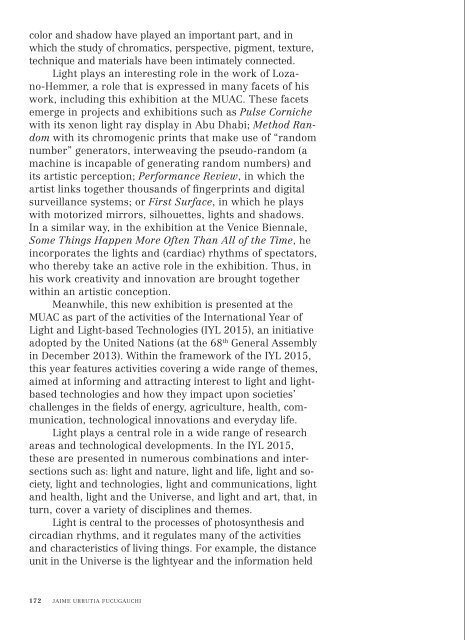Create successful ePaper yourself
Turn your PDF publications into a flip-book with our unique Google optimized e-Paper software.
color and shadow have played an important part, and in<br />
which the study of chromatics, perspective, pigment, texture,<br />
technique and materials have been intimately connected.<br />
Light plays an interesting role in the work of Lozano-Hemmer,<br />
a role that is expressed in many facets of his<br />
work, including this exhibition at the MUAC. These facets<br />
emerge in projects and exhibitions such as Pulse Corniche<br />
with its xenon light ray display in Abu Dhabi; Method Random<br />
with its chromogenic prints that make use of “random<br />
number” generators, interweaving the pseudo-random (a<br />
machine is incapable of generating random numbers) and<br />
its artistic perception; Performance Review, in which the<br />
artist links together thousands of fingerprints and digital<br />
surveillance systems; or First Surface, in which he plays<br />
with motorized mirrors, silhouettes, lights and shadows.<br />
In a similar way, in the exhibition at the Venice Biennale,<br />
Some Things Happen More Often Than All of the Time, he<br />
incorporates the lights and (cardiac) rhythms of spectators,<br />
who thereby take an active role in the exhibition. Thus, in<br />
his work creativity and innovation are brought together<br />
within an artistic conception.<br />
Meanwhile, this new exhibition is presented at the<br />
MUAC as part of the activities of the International Year of<br />
Light and Light-based Technologies (IYL 2015), an initiative<br />
adopted by the United Nations (at the 68 th General Assembly<br />
in December 2013). Within the framework of the IYL 2015,<br />
this year features activities covering a wide range of themes,<br />
aimed at informing and attracting interest to light and lightbased<br />
technologies and how they impact upon societies’<br />
challenges in the fields of energy, agriculture, health, communication,<br />
technological innovations and everyday life.<br />
Light plays a central role in a wide range of research<br />
areas and technological developments. In the IYL 2015,<br />
these are presented in numerous combinations and intersections<br />
such as: light and nature, light and life, light and society,<br />
light and technologies, light and communications, light<br />
and health, light and the Universe, and light and art, that, in<br />
turn, cover a variety of disciplines and themes.<br />
Light is central to the processes of photosynthesis and<br />
circadian rhythms, and it regulates many of the activities<br />
and characteristics of living things. For example, the distance<br />
unit in the Universe is the lightyear and the information held<br />
in light allows us to estimate movements, accelerations, and<br />
the chemical composition of stars and galaxies.<br />
The year 2015 marks various anniversaries of discoveries,<br />
scientific advances, and technological innovations<br />
related to light. For more than a millennium, efforts to understand<br />
light and its applications have built our knowledge of its<br />
nature, thus leading to numerous findings and developments.<br />
Among them are Ibn al-Haytham’s Book of Optics, or Kitab<br />
al-Manazir, in seven volumes; the discovery of the moons of<br />
Jupiter by Galileo Galilei; studies on the nature of eclipses<br />
and the solar system by Copernicus and Kepler; Isaac Newton’s<br />
measurement of the distances between the Earth, the<br />
Moon and the Sun and his corpuscular theory of light; James<br />
C. Maxwell’s experiments in the spectral decomposition of<br />
light and fluorescence, his research on the wavelike nature<br />
of light, the phenomenon of interference, electromagnetism<br />
and his electromagnetic theory and the dual nature of light,<br />
the photoelectric effect, the speed of light and special relativity<br />
theorized by Albert Einstein.<br />
Efforts to understand our surroundings in the solar<br />
system, the Sun, stars, galaxies, stellar clusters, supernovae,<br />
pulsars, black holes and the dimensions of the Universe,<br />
have used light, within the broad spectrum of radiations,<br />
matter, and dark energy. Many unknown factors remain,<br />
even regarding the basic aspects of light—for example, its<br />
dual nature as wave and particle—, and these continue to be<br />
researched and exploited, as in the development of photonics.<br />
Within this development there are also innovations<br />
and new technologies: lenses, telescopes, microscopes, the<br />
camera obscura, photography, cinema, telecommunications,<br />
laser surgery, fiber optics, magneto-optics, diodes, chromatographs,<br />
and sincrotrons or particle accelerators. In<br />
recent times we have seen the invention and development of<br />
lasers, including their applications in medicine and communication<br />
technologies, to measure distances, among other<br />
things. Today, the distance between the Earth and the Moon<br />
can be measured with a laser that allows us to quantify the<br />
speed with which our satellite is moving away.<br />
In light of the above, the IYL 2015 international program<br />
covers the areas of science, innovation and technological<br />
development, health, life, energy, culture, and art.<br />
It includes international as well as national organizations,<br />
172 JAIME URRUTIA FUCUGAUCHI<br />
LIGHT–SCIENCE, TECHNOLOGY AND ART 173


